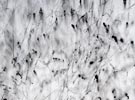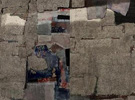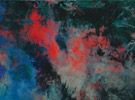You can treat your paintings as part of the environment. For example, they can be the end of a space or a window that leads to a boundless space.
You can also make your paintings like a natural element of the space. When I see the lines you drew on the walls of your studio, what I see is they naturally connect the walls and the floor. I see them as an extension of the building, which is not confined by any frame. As an artist, you can also choose to become part of the environment.
In this sense, your paintings change from the canvas on which they are painted. The purpose of the dots is to change the basic attribute of canvas. You aspire to replace the texture of canvas with the texture you create.
It is very exciting to see your paintings break through the boundaries of frames and become part of the environment.
Li Wei: That is a very good suggestion. As an architect, you are obsessed about space. I am more interested in the painting process, which has a lot to do with time. Chinese tradition tends to attach a fourth dimension of time, to a three-dimensional space. I wish to create dynamic processes for static paintings and to further explore the relationship between time and space.
Tang Keyang: I think you can be more audacious with regard to the themes of your works. Your can be more abstract and more optimistic when recreating traditional images and you can throw off the shackle of existing standards.
Li Wei: Yeah, I should free my mind, further.
Tang Keyang: Moreover, I think you can do translation of images more than one time. You can even first translate A to B and then translate B back to A.
Li Wei: Sometimes I imagine how one thing behaves at one point of the translation process and behaves differently at another point. After five to ten times of translation, the image may have been disengaged from the original and has become very abstract.
Tang Keyang: The reason I like the Landscape series is that I think its original is akin to traditional Chinese paintings. Traditional Chinese paintings are more than a reflection of natural landscapes. In this sense, they have already been translated for one time. So translation on this basis can further enrich the image. You are not interested in miniature scenery or simple emotion, which tend to be trivial. It seems to have to do with your education. You majored in fresco, a subject that attaches equally great importance to ornamentation and space. I’m more interested in the latter, because fresco is more than external ornamentation, it is an integral part of the space. Most traditional Chinese frescos are directly painted on buildings. Instead of simply showing concrete images, they are meant to create the environment which allows the audience to feel. Most traditional buildings do not have good lighting conditions and you cannot see the frescos clearly. The images of the frescos, however, are ubiquitous and you can feel them anywhere in the building.
Li Wei: Many frescos are painted at public places, like temples. They have a very large audience.
Tang Keyang: Many of your works are related to natural phenomena. They describe more than pure weather. They are a mixture of fog, rain and other phenomena. They are like the filter function of Photoshop used to modify pictures, which is also a converting mechanism. The filters can improve the color, layout and texture of your images and help you immerse the audience in the environment you created.
You can go one step further in two directions. Many of your works reflect that you have possessed the mentality of an architect.
Li Wei: What is the mentality of an architect?
Tang Keyang: Most people take what they want to see out of their surrounding environment and then observe the object. Architects, however, go into the environment and navigate inside the environment. They are not anxious to find what they wanted to see and they are not afraid of getting lost in the environment. They act as if they are creating and perceiving the environment at the same time. When I see your works, what I see are not concrete objects, neither the paper crane nor the gate. What I see is a lot of miniature spaces consisting of lines. They are connected and overlap with each other, motivating the audience to stroll around them. The maze simply fascinates the audience.
Li Wei: Without the confinement of too many details, both the audience and the painter have their freedom.
Tang Keyang: Exactly. We do not need to put a whole shopping cart on a painting. We just need to describe a fraction of it. And for us, it is no longer a shopping cart. It is an entire city. Similarly, we can transform net to a furrowed mountain. This is another kind of conversion and it shares a lot in common with the dots you use.
In other words, you need to combine different scopes, integrate different techniques and synthesize different elements. Doing so is not meant to bring people inside reality. Instead, it is meant to bring people into uncharted territories.
Li Wei: The effect is produced with a layered space.




